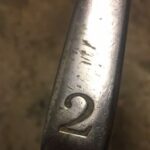The driver, along with the putter, can be the most divisive club in the bag. Some golfers love it and can’t wait to get it out of the bag. Others will do anything to avoid it. Many of us will move from one category to another other their golfing lifetime. This is the case for me at least. I am happily heading back to the land of the big stick but have been through a few years when all I wanted was a golf driver replacement. Let’s look at a few of the options for those who are struggling with the longest club in the bag.
- Distance off the tee is important
- a 3 wood might not be the answer
- should you just work on your driver?
- driving irons, hybrids and fairway wood can all work
More Distance Off the tee = Lower Scores
This is something that sits a little bit uncomfortably with me. The fact of the matter is that the further you are up the hole, the better you chances are to score. Stats show this to be the case. Proximity to the hole gets better and dispersion tighter when we have a more lofted club in our hands. The reason why this is a little bit uncomfortable for me is that I spent a while trying to convince myself of quite the opposite.
When I was struggling to keep my driver on the planet, I would justify the fact that I wasn’t hitting it by telling myself that distance wasn’t important. Better to be 200 yards on the fairway than 300 out of bounds. This is self-evidently true and yet it doesn’t tell the entire story. There are plenty of golf holes where driver really isn’t the best choice. As an example, it can be a terrible idea to hit it on a couple of the par fours on my regular courses.
It brings trouble into play and makes the next shot significantly tougher. It also makes sense to play to your strengths. I would generally rather have a full nine iron into most greens rather than a three-quarter pitching wedge. It is just simpler for the ordinary golfer I currently am to put a full swing on a club rather than try to manufacture a shot that i really don’t practice.
This isn’t the same thing as hitting a shorter club when you are scared of the driver (as I was). I was leaving fifty yards or more on the table on wide open fairways by hitting a more lofted club off the tee. As much as a nine iron rather than a three-quarter wedge makes sense, anyone who says they would rather hit a six iron into a green compared to a pitching wedge needs to work on some things (and yes, that was my case!)
Changing Driver for Three Wood
Let’s leave this discussion aside for a moment and look at what the options are if you don’t want to (or can’t ) hit driver. The most obvious choice surely most be the next longest stick in the bag, the three wood. Actually, not so fast. I did this for a couple of seasons and I would say it might just be the worst option for many. Why is this?
Well, let’s think about why the driver can be problematic. Firstly, it is the longest club in the bag, often 45 inches or more. A three wood is shorter, but perhaps only an inch or two and this still makes a tricky club to find the centre of the face. Secondly, a driver has the least amount of loft of any club in the bag and this is makes it both harder to control face direction at impact and also have less backspin and therefore be more susceptible to side spin and those wonderful hooks and slices. Don’t see them with your pitching wedge, do you? Sure, the three wood has more loft, but perhaps 3-5 degrees more and is still going to suffer from the same issues.
Finally, the three wood actually has a distinct disadvantage over the driver. Modern drivers have a 460cc head which is huge compare to a three wood. This actually makes them the most tolerant club in the bag in terms of the amount of face you actually have to make contact with the ball.
The Case for a fairway Wood
Before you throw the rest of your fairway woods away, I actually believe that a fairway wood is a really good driver replacement for many people. However, I think most of us should look at something like a five wood rather than a driver. I have recently put an old big Bertha five wood in my bag and it is a really valuable club. It has 19 degrees of loft which would make it actually a pretty weak five wood by modern standards, and shaft length is probably around 41 inches I would guess. This might seem like much but the few inches less and the few degrees more suddenly make this a friendly club to hit both off the tee and off the fairway. So much so that I am seriously considering adding in something like a nine wood (yes, really!)
Fairways do have one or two distinct advantages compared to other tee options if you are looking to replace your driver. The first thing to think about is swing speed. Although more loft is easier to hit, it generally also means a much shorter shaft and for those of us who have less than pro swing speed, a shorter shaft is going to mean less speed and consequently less distance.
I still have a reasonable amount of clubhead speed and this is true for me. If you are slower on the swing speed scale, that longer, lighter shaft (without being too long) could be a real asset in finding a few more yards off the tee. The other reason to look at a higher-lofted fairway is that it is quite a versatile club. It is great off the tee, but also easy to get airborne off a fairway. Compared to a long iron, it will certainly hit the ball higher which means that is can be invaluable if you need to get it up and over trouble like water, bunkers or whatever.
Fairway Wood, Hybrid or Long iron?
Of course, a fairway wood is one option, but it might not be the best for you. I have looked at the advantages and disadvantages of these three before but here is a little summary of what might make one of the other better for your game. There is no one size fits all here.
Until recently, the choice would have been fairly simple for me. I would happily bag a three iron and have also played a two iron. These aren’t necessarily your old school long irons, but more driving irons with a reasonable degree of forgiveness and a chunky head design. I have (or perhaps had) a solid iron game and plenty of swing speed which meant that a shorter, heavier shaft wasn’t a problem. I could get a three iron up in the air easily off the tee and a forced carry wouldn’t scare me.
While this is still somewhat the case, it is less so than a few years ago. I can still smash a driving iron, but I need to be going after it a bit to get the best out of it. This can be a problem because swinging at 95% rather than 80% brings the mishit into play. Even with these modern head shapes, an iron isn’t going to explode off the face with the same trampoline effect (COR)t (COR) as a fairway or even a hybrid.
However, I do still value a long iron and you might too, even if you don’t hit it as far as you used to. For example, if you are playing on dry Summer fairways, it is a fantastic club. If there is no trouble to carry, hitting a low stinger-type shot off the tee is a very safe play. There is no chance of it flying out of bounds and it can run so far that it might actually be up there in terms of distance with a driver or at the very least a fairway wood. Of course, the opposite logic also applies. In the Winter, you would be brave or suicidal to be hitting a long iron off the tee. Very little run out, shorter carry in the cold air and the joys of feeling the shot rattle up your arm as you thin one!
Is the Hybrid the Perfect Solution?
This brings us to the hybrid. It might be the perfect solution for some. A shorter shaft than a fairway wood, plenty of loft, a springy face that lets the ball ‘pop’ off and fly high. Indeed, for many golfers it should be one of the first clubs in their bag. However, you will find some golfers who really struggle with it. It can be a strange club for many because they don’t know whether they should sweep it like a fairway wood or hit down on it more like an iron. This makes it a very complicated club for this (admittedly small) group of golfers to hit. Hybrids also tend to sit fairly upright and sometimes with a relatively closed face. This is why it has a reputation for some as a ‘hook machine.’
If you are someone who can hit a hybrid comfortably, I would say that it is foolish not to have one in your bag and to use it as your safe club off the tee.
A Golf Driver Replacement is a Temporary Solution
Whether you choose fairway, hybrid or long iron, or actually a combination of all three, don’t make the same mistake I did. Don’t think that you can put the driver in the cupboard and forget about it. Your aim should be to work on the driver until it is a solid option in its own right. Some holes are going to call for a shorter tee shot. Maybe it a very tight hole or there is trouble out there. Perhaps it makes sense to play to your favourite distance. However, when you have a nice open fairway, you need to be able to pull the driver out and let rip. Your scorecard will appreciate it 😉





